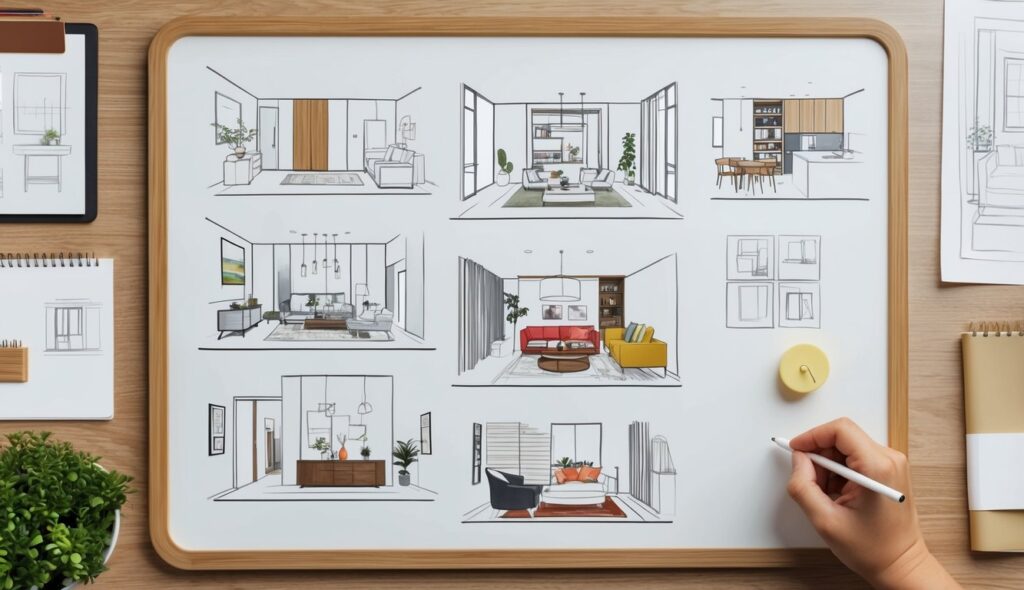Window blinds are a crucial element in enhancing indoor climate control. By regulating the amount of natural light and heat entering a space, blinds can significantly improve thermal comfort for occupants.
Remember to repin your favorite images!
Properly chosen window blinds can lead to substantial energy savings, reducing heating and cooling costs by up to 20%.
In the realm of architectural design, understanding the integration of window blinds into a building’s overall climate control strategy is essential.
Solutions such as cellular shades are particularly efficient, offering superior insulation properties compared to traditional Venetian blinds.
These shades can mitigate heat loss during winter and minimize heat gain during summer, thereby boosting energy efficiency.
For architects focused on creating sustainable and comfortable living environments, selecting the right window coverings is paramount.
Techniques like using blinds with high R-values can greatly enhance a building’s climate control capabilities.
This attention to detail not only optimizes energy performance but also ensures a high level of comfort for the building’s occupants.
Window Blinds and Energy Efficiency
Window blinds play a crucial role in regulating indoor climates, helping to optimize energy consumption and manage solar heat gain.
This section examines the thermal benefits of blinds and their impact on controlling solar heat gain in buildings.
Thermal Benefits of Blinds
One of the main advantages of window blinds is their ability to improve a home’s thermal performance.
By reducing heat loss during the winter and minimizing heat gain during the summer, window blinds can significantly lower energy consumption.
Blinds with better R-values provide more effective insulation.
Blinds such as Keego Zebra Blinds offer a dual-layer design, which enhances insulation.
Cellular shades, for instance, can save up to 20% on heating energy by trapping air within their structure, acting as a barrier against thermal transfer.
These blinds help reduce the need for heating systems during cold months and cooling systems during hot months.
Shutters and other forms of shading devices also contribute to energy savings by reducing the reliance on HVAC systems.
Properly selected and installed blinds help maintain a consistent indoor temperature, making them a valuable addition to any energy-efficient home.
Solar Heat Gain and Control
Window blinds are essential for managing solar heat gain.
By controlling the amount of solar radiation that enters a room, blinds reduce the heat build-up, improving energy efficiency.
Awnings, for example, can reduce solar heat gain by up to 65% on south-facing windows and 77% on west-facing windows.
Blinds like the Keego Cordless Window Shades allow occupants to adjust the amount of direct sunlight that enters a room.
This feature is particularly useful during the cooling season where preventing excessive solar heat gain can result in significant energy savings.
Furthermore, some blinds help enhance daylighting by diffusing natural light without causing glare or excessive heat.
Modern window treatments can balance the benefits of natural lighting with minimized heat gain, contributing to a building’s overall energy performance.
By selecting blinds with an appropriate solar heat gain coefficient (SHGC), architects can optimize the energy use within residential or commercial spaces.
Design and Usability of Blinds
The design and usability of window blinds are crucial in controlling indoor climate. This involves considering material and color to optimize energy efficiency and embracing technological innovations to enhance functionality.
Material and Color Impact
The material and color of interior window blinds play a significant role in their efficiency.
Blinds made of reflective film or light-colored fabrics can reflect more sunlight, reducing heat gain.
Conversely, dark-colored blinds can absorb more heat, which might be preferred in cooler climates for increased warmth.
Fabric types such as blackout and translucent materials also impact usability.
Blackout fabrics provide enhanced thermal insulation by blocking sunlight completely, while translucent fabrics offer partial shading, balancing light control with visibility.
Reflective blinds offer an optimal blend of light reflection and thermal management, particularly effective in sunny regions.
Design choices like roller shades and roman shades also influence usability.
Roller shades are known for their sleek design and ease of use, while roman shades offer a softer, more traditional look.
The aesthetics and functional demands of the space will often dictate the best choice for materials and colors.
Technological Innovations
Technological advancements have greatly enhanced the usability of blinds.
Automated shading systems, including motorized blinds, provide users with precise control over indoor climate.
Automated systems can be integrated with smart home technology, allowing remote adjustments and scheduling through mobile apps or voice commands.
Smart blinds are designed to optimize energy consumption by adjusting based on real-time sunlight and temperature data.
For example, motorized blinds from Keego Blinds offer a seamless blend of efficiency and style, allowing for easy operation and enhanced energy savings.
Energy efficiency is further improved through solar control methods that adjust blinds based on the solar profile angle.
Automated shading systems that include features like daylight harvesting maximize natural light while minimizing the need for artificial lighting, thus saving energy.
For those interested in upgraded home devices, roller shades by Keego Blinds provide a functional solution.
These innovations not only enhance the user experience but also contribute significantly to energy conservation.
Automated systems ensure consistent and optimized control over indoor environments, making them an essential feature in modern building design.

